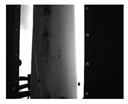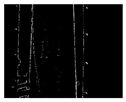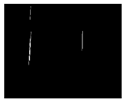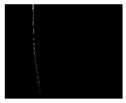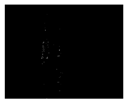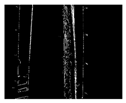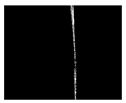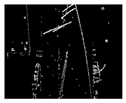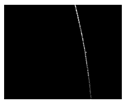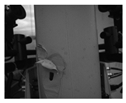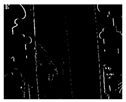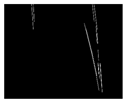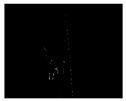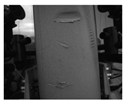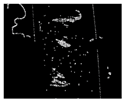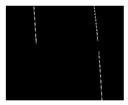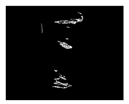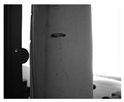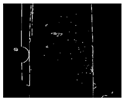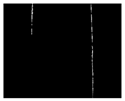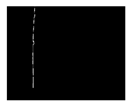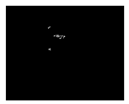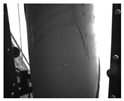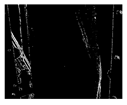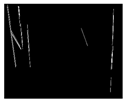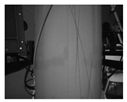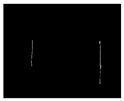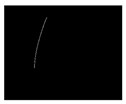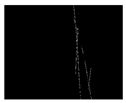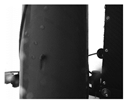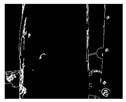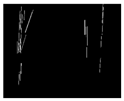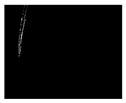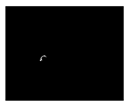Abstract
Surface defects on stay cables are primary contributors to wire corrosion and breakage. Traditional manual inspection methods are inefficient, inaccurate, and pose safety risks. Recently, cable-climbing robots have shown significant potential for surface defect detection, but existing designs are constrained by large size, limited operational speed, and complex installation, restricting their field applicability. This study presents an intelligent robotic system for detecting cable surface defects. The system features a dual-wheel driving mechanism, and a computer vision–based defect recognition framework is proposed. Image preprocessing techniques, including histogram equalization, Gaussian filtering, and Sobel edge detection, are applied. Interfering information, such as sheath edges and rain lines, is removed using the Hough Line Detection Algorithm and template matching. The geometry of identified defects is automatically calculated using connected component analysis and contour extraction. The system’s performance is validated through laboratory and field tests. The results demonstrate easy installation, adaptability to cable diameters from 70 mm to 270 mm and inclination angles from 0° to 90°, and a maximum speed of 26 m/min. The proposed defect recognition framework accurately identifies typical defects and captures their morphological characteristics, achieving an average precision of 92.37%.
1. Introduction
Over the past three decades, cable-stayed bridges have progressively emerged as one of the foremost designs for modern long-span bridges due to their esthetically pleasing structures and impressive load-bearing capabilities, thus finding widespread application worldwide. Cables are critical load-carrying components in cable-stayed bridges, exposed to natural environments for extended periods and subjected to high stress, making them vulnerable to damage such as sheath breakage, corrosion, and wire breakage [1,2]. Sheath breakage is one of the most frequently observed damage during inspections, often resulting from prolonged exposure to rain and sunlight [3,4]. After sheath breakage, the steel wires inside the cable are exposed to natural environments, accelerating the processes of corrosion and crack initiation [5], ultimately leading to wire fracture [6,7]. Therefore, it is essential to develop effective surface defect detection methods for stay cables.
The traditional method for detecting cable surface defects is manual inspection, which primarily depends on visual assessment [8]. Inspection personnel use telescopes and cameras with telephoto lenses to find the surface defects, a process that is time-consuming and imprecise due to constraints on observation positions. Another manual inspection method involves using ladder trucks or construction baskets to approach the cable surface for inspection and maintenance, which is inefficient and poses safety risks [9,10]. Due to these limitations, various alternative inspection methods have been proposed. Unmanned aerial vehicles (UAVs) exhibit promising potential for detecting surface defects due to their high mobility, capability to capture images of difficult-to-access components, and high efficiency [11,12]. While UAVs have been extensively utilized for inspecting bridge piers, decks and towers [13,14,15,16,17], limitations arise when applying them to stay cables [18]. Due to safe obstacle avoidance distance constraints, UAVs may not be able to approach the cable surface closely enough to capture precise images of defects or achieve a 360° field of view of stay cables. Currently, cable-climbing robots are among the most promising new approaches for detecting cable surface defects [19,20,21]. These robots are designed to crawl along the stay cable, capturing high-resolution images with embedded cameras. By incorporating computer vision technology, cable surface defects can be automatically identified, significantly enhancing the efficiency of cable surface inspection [6,22,23].
Several cable-climbing robots have been developed and utilized in cable stayed bridges [24,25] and suspension bridges [26,27] over the past decades. Advances in mechanical design have resulted in reduced self-weight, increased operation speed, and enhanced obstacle-overcoming capabilities [28,29,30]. In addition to image acquisition devices, some robots are equipped with Non-Destructive Testing (NDT) devices. The magnetic flux leakage (MFL) method has proven to be an effective technique for detecting both uniform and pitting corrosion of steel wires inside cables [31]. Such NDT devices have been integrated into cable-climbing robots [25,32], while their self-weight often exceeds the loading capacity of cable-climbing robots [33], limiting their use in field tests. Meanwhile, cable repair devices [34] have also been integrated into cable-climbing robots, which can automatically repair minor defects on cables. Despite automating the cable inspection process, the efficiency of these robots remains constrained by their operation speed, installation procedures, and adaptability to various cable diameters [35]. Therefore, a cable-climbing robot with lightweight construction, rapid crawling speed, good encapsulation, and straightforward installation procedures is essential for field tests.
While many studies have focused on the mechanical design of cable-climbing robots, computer vision technology has also been extensively applied to defect recognition in civil structures [36,37]. Consequently, some research has explored the use of computer vision for automated cable defect detection. Ho et al. [38] applied the Principal Component Analysis (PCA) method to evaluate the similarity between captured images and sample defect images. Li et al. [39] developed a simplified scale-invariant feature transform (SIFT) algorithm for image mosaicking. Hou et al. [40] employed concrete crack datasets through transfer learning to address the challenge of limited datasets for cable surface defect images. Xu et al. [41] introduced an effective defect detection method by combining computer vision and diameter measurement. However, a comprehensive framework for cable surface defect recognition still requires further development to meet practical needs in cable inspections.
This study presents a lightweight intelligent robotic system with swift climbing capabilities and adaptability to various cable diameters. A defect recognition framework, based on computer vision technology, was developed to eliminate interference, identify defect regions, and automatically calculate defect geometry. Both laboratory and field tests were conducted to validate the system’s mechanical design and defect recognition capabilities. The rest of this paper is organized as follows: Section 2 presents the mechanical design and key performance indicators of the proposed system. Section 3 outlines the stages of the proposed defect recognition framework. Section 4 discusses the implementation and results of laboratory and field tests conducted with the intelligent robotic system. Finally, conclusions are presented in Section 5.
2. Mechanical Design of the Intelligent Robotic System
2.1. Overall Design
The main challenge in designing the intelligent robotic system is to adapt it to the complex service conditions of stay cables. These cables are cylindrical structures composed of multiple steel wires encased in polyethylene (PE) sheaths, whose surfaces often feature irregularities caused by defects or rain lines. Positioned at elevated locations, stay cables typically have inclination angles between 30° and 90° and diameters ranging from 70 to 270 mm. Moreover, vibrations induced by wind and traffic loads further complicate the robot’s stable operation.
To effectively address the challenges associated with cable inspections, the robotic system must exhibit the following characteristics: (1) a lightweight structure that allows for easy installation and adapts to various cable diameters, thereby improving inspection efficiency; (2) a driving mechanism with sufficient power to overcome its self-weight and any obstacles, ensuring stable and rapid climbing; (3) a high-resolution image acquisition module to support accurate automatic defect recognition.
The proposed mechanical design of the intelligent robotic system consists of three main components: the driving mechanism, the image acquisition module and the battery compartment, as shown in Figure 1. The driving mechanism includes two servo motor-driven power systems that provide the necessary force for ascent. The image acquisition module captures real-time data of the cable surface, which is used for subsequent image processing to automatically identify defects. The battery compartment is positioned at the lower section of the system to keep the center of gravity below the cable’s diameter, thereby preventing any shift or deflection during climbing. To reduce weight while maintaining strength, non-structural components are made of plastic, and parts of the structure are constructed from carbon fiber to ensure strength while simultaneously reducing weight. The key performance indicators of the proposed system are detailed in Table 1.

Figure 1.
Three-dimensional model of the intelligent robotic system.

Table 1.
Key performance indicators of the proposed system.
2.2. Driving Mechanism
The driving mechanism is a crucial component that supports various sensors and controllers. It must have sufficient driving capacity to counteract its own weight and carry the load of the detection devices. Additionally, the mechanism must ensure the stability of the entire system, considering the cable vibrations caused by vehicles and wind, as well as the large inclination angles and deflection of the stay cable.
Therefore, as illustrated in Figure 2, the driving mechanism employs a dual-wheel driving structure, composed of two active wheels and two passive wheels. The passive wheels are positioned above the stay cable, while the two active wheels, each driven by a servo motor, are positioned below. These active wheels, made of aluminum alloy and covered with rubber cladding, apply inward pressure on the stay cable through a preloading bolt, ensuring a secure grip and generating sufficient friction.
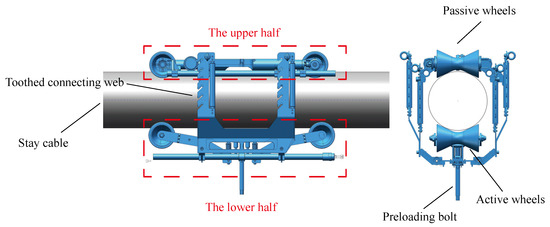
Figure 2.
Structure of the driving mechanism.
In order to analyze the stress state of the system during operation, the mechanical schematic is illustrated in Figure 3. The driving force is provided by the friction between the active wheels and the stay cable:
where represents the driving force, denotes the friction between the active wheel and the stay cable, denotes the friction coefficient, denotes the normal force applied to the active wheel by cable surface, denotes the total mass of the whole system and denotes the inclination angle of the stay cable.
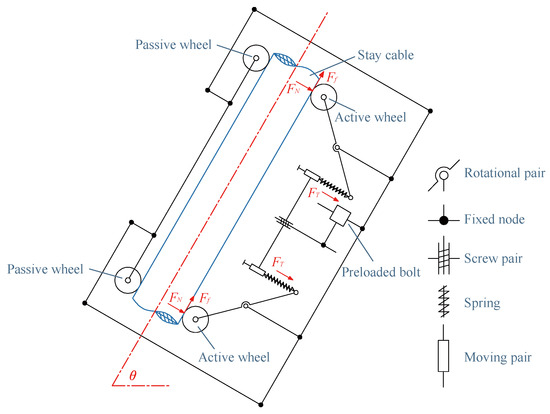
Figure 3.
The mechanical schematic of the system.
Under vertical working conditions (where ), considering a total system mass of 15 kg, and taking and a safety factor of 1.5, the required normal pressure is calculated to be 187 N. Furthermore, employing the principle of lever balance, the required spring force is calculated to require a pressure of 133 N to maintain equilibrium. Therefore, a spring with a maximum load of 422 N and a maximum deformation of 22 mm is chosen.
The robot’s obstacle negotiation capability relies on two key components: the spring and the soft silicone grease material coating the wheels. The spring’s elastic coefficient is calculated to be 19.2 N/mm, providing a spring force of 133 N under vertical working conditions, which allows for an additional 15 mm of deformation. Consequently, the robot’s maximum obstacle clearance is conservatively estimated to be 10 mm, sufficient to navigate rain lines and defects on the stay cable.
Adaptivity to various cable diameters is achieved by dividing the system into an upper half and a lower half, connected by a toothed web plate. The toothed web plate offers multiple locking positions, allowing adjustment for cable diameters ranging from 90 mm to 260 mm. Once the robot is installed on the cable, the preloading force exerted on the cable can be fine-tuned by rotating the preloading bolt, ensuring stable and reliable operation.
2.3. Image Acquisition Module
The image acquisition module, depicted in Figure 4, captures the condition of the cable surface, enabling subsequent image processing for defect detection. Four industrial digital cameras are mounted radially around the cable, with adjustable positions to accommodate various cable diameters, ensuring full 360° coverage. Adjustable light shades are employed to counter direct sunlight by modifying their angles based on sunlight intensity and direction, thus ensuring uniform light distribution and significantly improving image quality. The sensing components include a displacement sensor and an obstacle avoidance sensor. The displacement sensor records the position of captured images, providing essential data for defect localization. This is accomplished by mounting an external rotary encoder on the drive wheels, which measures wheel rotation angle and speed, generating pulse signals proportional to the wheel revolutions. The microcontroller unit (MCU) processes these pulse signals to calculate the robot’s longitudinal displacement based on the known wheel diameter and circumference. The MCU also triggers the camera to capture images at predefined intervals of 0.15 m, ensuring uniformly spaced inspection data along the cable. Both odometry and image trigger signals are transmitted to the industrial computer, where each image is automatically associated with its corresponding displacement information. By combining encoder-based odometry data with image resolution and pixel size, the position of surface defects can be accurately determined, with a resolution of defect localization along the cable length approximately 0.01 m. The obstacle avoidance sensor, an ultrasonic device, enables the robot to automatically reverse upon detecting the surface of the bridge tower and terminate operation at a predetermined height above the bridge deck.
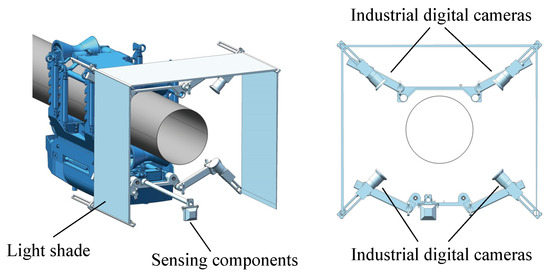
Figure 4.
Structure of image acquisition module.
3. Defect Recognition Framework
After image acquisition, defects can be automatically identified through image recognition technology. A defect recognition framework is proposed in this section, as shown in Figure 5.

Figure 5.
The proposed defect recognition framework.
3.1. Illumination Compensation
Given the substantial length of the cable, the image acquisition process may take considerable time, leading to potential issues with uneven illumination in the captured images. The original image’s grayscale distribution may be restricted to a narrow range, resulting in reduced clarity. Overexposed images tend to have their grayscale levels concentrated in the high brightness range, whereas underexposed images concentrate grayscale levels in the low brightness range. Consequently, implementing illumination compensation is crucial to ensure uniform brightness and enhanced contrast.
Histogram equalization [42] is a simple yet efficient image enhancement technique used to enhance image contrast, particularly in images with limited dynamic range. By applying histogram equalization, the original image histogram is adjusted to achieve a uniform distribution, as illustrated in Figure 6. Consequently, the overall contrast of the image is improved, as shown in Figure 7.
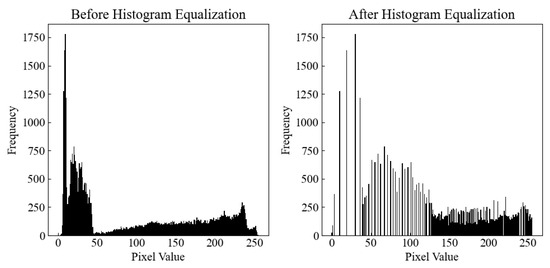
Figure 6.
Grayscale histogram distribution.
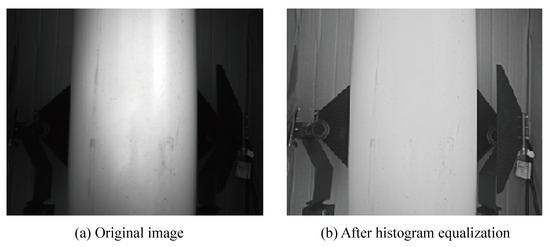
Figure 7.
Images before and after histogram equalization.
3.2. Edge Extraction
To identify the defect region, Gaussian filtering, Sobel edge detection, and image binarization are applied after illumination compensation.
First, noise in the original image must be filtered out. Given that surface defects typically contain high-frequency components, the Gaussian filter is chosen for its gentler smoothing effect and superior edge preservation. The Gaussian filter, a linear smoothing filter, operates based on the Gaussian function. The core principle of the Gaussian filter is to replace each pixel value in the original image with the weighted average of its neighboring pixel values, determined by the size of the Gaussian kernel. Here, a two-dimensional zero-mean discrete Gaussian function is used:
where denotes the gaussian coefficient, which is the weight after normalization, denotes the shape factor, denote the relative position to the center point. In this study, and a Gaussian kernel size of 41 × 41 is selected. Through Gaussian filtering, interference information, such as high-frequency noise induced during image acquisition, is filtered out, while defects-related information is preserved.
Secondly, an edge detection algorithm is employed to minimize irrelevant information while preserving the essential structural features of the image. The Sobel operator, a widely used edge detection method, is known for its efficiency and reasonable accuracy [43]. It identifies edges by detecting significant changes in pixel values, indicated by the highest first derivative. The Sobel operator calculates edges by taking the weighted difference between pixel values in adjacent regions. By combining Gaussian smoothing with differential derivation, the Sobel operators for the x and y directions are defined in Equation (3). Convolution of the Sobel operator with the image yields the gradient in the x and y directions, as shown in Equation (4). The edge information is then extracted by superimposing these gradients, as indicated in Equation (5).
Finally, binarization is utilized to identify potential defect areas. Edge detection results indicate that regions with low gray values are less likely to represent edges, while regions with high gray values are more indicative of edges. To enhance edge detection accuracy, weak edge responses must be filtered out. According to Equation (6), if the gray value is below 100, it is classified as background information and set to the minimum value. Conversely, if the gray value exceeds 100, it is assigned the maximum value. The images before and after edge extraction are shown in Figure 8.
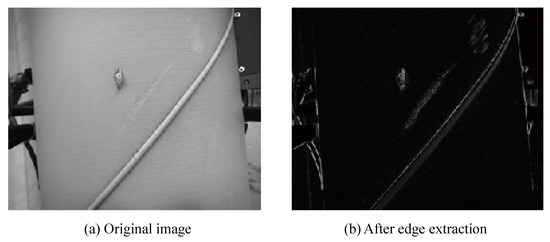
Figure 8.
Images before and after edge extraction.
3.3. Remove Background Information
As shown in Figure 8b, the identified potential defect area still includes rain lines and background information outside the sheath. To eliminate this background noise, the edges of the sheath must be identified. Since these edges generally appear as straight lines, the Hough Line Detection Algorithm is utilized in this study. The fundamental principle of this algorithm is based on the duality between points and lines in the image and parameter domains [44]. The parametric equation of a line is presented in Equation (7), as shown in Figure 9:
where denotes the distance from origin to , denotes the Angle between the x-axis and the vertical line of . By changing the value of , each point on corresponds a line in the parameter domain, which interacts on the same point . Therefore, multiple points collinear in the image domain is transferred into Multiple lines intersect at the same point in the parameter space. The presence of lines can be determined by the intersecting points in the parameter space.
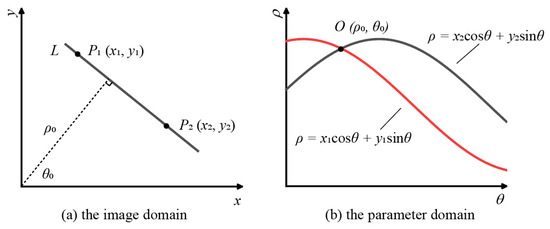
Figure 9.
The basic principle of the Hough Line Detection Algorithm.
Through the Hough Line Detection Algorithm, the points in Figure 8b are transformed into the parameter domain, as shown in Figure 10a. By counting the number of lines that intersect each point in this parameter space and applying a threshold, the presence of lines in the original image can be determined. The detected lines, depicted in Figure 10b, reveal the presence of rain lines and the sheath edges. The identification of the sheath edges is achieved by analyzing the angle of the lines and their proximity to the image’s edge.

Figure 10.
Detected lines by the Hough Line Detection Algorithm.
3.4. Remove Rain Lines
As shown in Figure 11a, rain lines are still present and must be removed. Template matching is a technique used to locate the region of an image that most closely resembles a given template image. Given an original image and a template image , the template is scanned across the original image to compute the similarity between each region and the template. Three methods are commonly utilized for calculating similarity: Sum of Absolute Differences (SAD), Sum of Squared Differences (SSD) and Normalized Cross Correlation (NCC). The NCC based method is utilized in this study due to its rapid processing speed and adaptability to variations in lighting conditions [45], which is calculated by Equation (8):
where denotes the normalized coefficient, denote the size of the template image, and denote the pixel gray value of the matching image and the template image, respectively. The greater the value of , the more similar it is to the template. Areas with a calculated value exceeding a certain threshold (0.7 in this study) are deemed similar to the template. The typical rain line templates used in this study are illustrated in Figure 12, with dimensions of 64 × 64 pixels. Each template is iteratively rotated by 15 degrees to calculate the similarities with the scanned regions. Regions showing strong matching responses to the templates are identified and subsequently removed as rain lines. The identified rain lines are illustrated in Figure 11b.
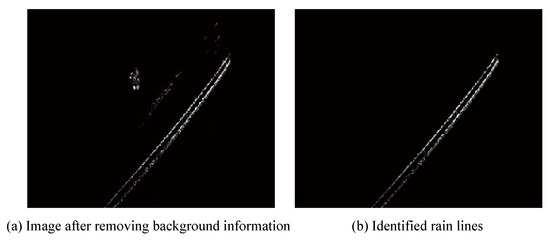
Figure 11.
Initial image and identified rain lines.

Figure 12.
Typical rain line templates.
3.5. Automatic Defects Geometry Calculation
After removing the background information and rain lines, the remaining pixel areas are identified as defects regions, as shown in Figure 13a. To calculate the defect geometry, image dilation is first employed to expand the identified defect area. Connected components are then calculated, and those with small areas below a certain threshold value are filtered out. By determining the length and area of the connected components, the defect geometry can be automatically identified. The whole process and calculated defects geometry properties are shown in Figure 13 and Table 2.

Figure 13.
The process of automatic defects geometry calculation.

Table 2.
Calculated defects geometry properties.
4. Experimental Tests and Discussion
4.1. Laboratory Tests
To evaluate the robot’s climbing performance under various service conditions, laboratory test was conducted considering different inclination angles and weather scenarios. The first experiment involved a vertical stay cable with a diameter of 130 mm, as shown in Figure 14a. The results demonstrated that the robot was able to climb and descend efficiently, achieving a climbing speed of 18 m/min. In the second experiment, a stay cable with a diameter of 120 mm and an inclination angle of 30 degrees was tested, as shown in Figure 14b. A 10 mm diameter cable was placed on the PE sheath to simulate rain lines, and the sheath was wetted to mimic rainy conditions. During this test, the first-generation prototype with the two-wheel design exhibited noticeable speed fluctuations, occasional slippage, and minor lateral oscillations during climbing, particularly under wet conditions. To overcome these issues, the robot was redesigned with a four-wheel configuration, which substantially enhanced traction stability and motion control. This improvement ensured reliable climbing performance even in slippery and windy environments, laying the foundation for subsequent field testing. The robot exhibited stable climbing and descending performance, reaching a climbing speed of 26 m/min. These results confirm that the robot meets the requirements for stay cable inspection in field tests.
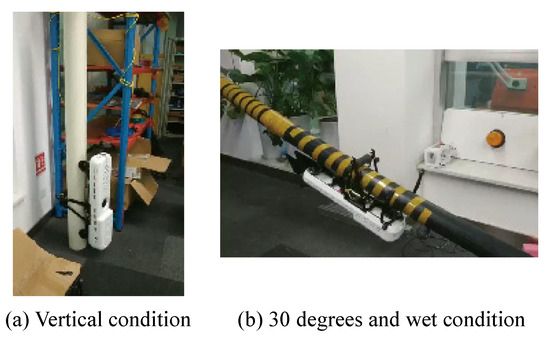
Figure 14.
Laboratory test.
4.2. Field Tests
To assess the performance of the developed intelligent robotic system and validate the accuracy of the proposed defect recognition framework, on-site stay cable inspections were first conducted on two cable-stayed bridges with main spans of 688 m and 468 m, respectively. The inspections were carried out under overcast skies with light rainfall and wind speeds of 4 to 5 on the Beaufort scale. As depicted in Figure 15, the robot’s movements are controlled by the remote controller on the bridge deck through wireless transition. The raw images captured by the robot are transmitted to the laptop to provide a real-time monitoring. Defect recognition was subsequently performed using the developed software, in accordance with the proposed framework, as illustrated in Figure 16.

Figure 15.
Figures of field tests.

Figure 16.
The intelligent robotic system and defect visualization software.
During the field tests, the intelligent detection robot demonstrated stable and reliable performance. It climbed and descended the cables autonomously with minimal shaking or slippage, even under light rainfall, and automatically returned to its starting position upon approaching the bridge tower. The robot achieved an average speed ranging from 15 m/min to 18 m/min, with a decrease in speed observed as the inclination angle increased. Three typical cables were selected to validate the proposed defect recognition framework, with detailed properties presented in Table 3. The results of defect recognition are summarized in Table 4, Table 5 and Table 6. Peeling was accurately identified at 243.56 m on Cable 1#. Scratches were detected at 3.44 m on Cable 1# and at 6.71 m on Cable 3#. Grooves were the most frequently encountered defect, observed at 141.06 m on Cable 1#, at 14.25 m and 2.14 m on Cable 2#, and at 30.66 m on Cable 3#.

Table 3.
Properties of typical stay cables.

Table 4.
Typical defects of Cable 1#.

Table 5.
Typical defects of Cable 2#.

Table 6.
Typical defects of Cable 3#.
Following the validation of the robotic system’s stable operation and defect recognition capabilities, it was further tested on another cable-stayed bridge to assess its adaptability to varying cable diameters and field-testing efficiency. The selected bridge is a single-tower cable-stayed bridge with a main span of 220 m as depicted in Figure 17. There are 84 steel strand cables in total, with diameters ranging from 160 mm to 235 mm and inclination angles between 26 and 80 degrees. Due to monitoring devices are installed on 16 cables (LS21, LS14, LS08, LS01), a total of 68 cables were tested over three days, demonstrating the high efficiency of the robotic system in field tests. The system adapted well to cables with larger diameters, consistently maintaining a stable operating speed of approximately 16 m/min.
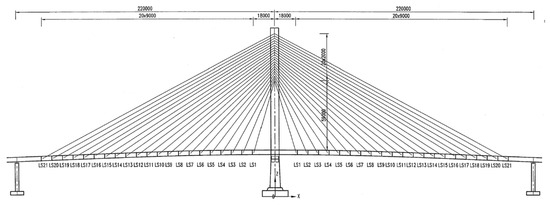
Figure 17.
The single tower cable-stayed bridge (units: mm).
During the field tests, a total of 1892 defect images were captured. Quantitative evaluation of defect detection performance generally requires complete knowledge of all true defects on the inspected cables, which is difficult to obtain in practice. Consequently, comprehensive indicators such as accuracy, recall, and false negative rates cannot be precisely determined at this stage. Instead, detailed manual verification of the detected defects was conducted to estimate precision, reflecting the reliability of the recognition results. The precision values for five representative cables with the highest number of detected defects were 84.21%, 93.44%, 90.57%, 97.73%, and 95.92%, respectively, yielding an average precision of 92.37% (Table 7). Most false positives were caused by greasy dirt on the cable surface. These results demonstrate that the proposed recognition framework achieves high precision and reliable defect identification performance under real-world field conditions.

Table 7.
The precision values for five representative cables.
Table 8 summarizes the typical defects observed on the northern side cables of the bridge, while Figure 18 illustrates representative examples. Greasy dirt was the most prevalent defect, although it has minimal impact on structural safety. Among all the scratches identified, the majority were short, measuring less than 0.35 m in length, with a few longer scratches approximately 1 m in length. These scratches were predominantly located near the bridge deck and tower, likely resulting from damage during transportation, construction, or the operational phase. Notably, considering that this bridge has only been in service for three years, the presence of scratches at such an early stage suggests that cable scratches may emerge relatively early in the bridge’s life cycle, potentially leading to corrosion of the internal steel wires. Therefore, regular inspection of cable surfaces is essential, even for newly constructed bridges, to ensure long-term structure safety.

Table 8.
Typical diseases of cables in northern side.
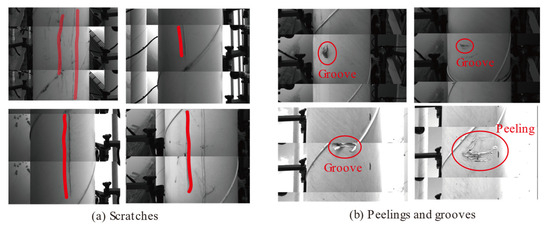
Figure 18.
Typical defects on cables.
4.3. Discussion
As demonstrated by the above results, the proposed mechanical design of this robot exhibits excellent capability to stably climb and overcome obstacles, regardless of wet or dry conditions, varying angles and different surface defects of stay cables. The small, lightweight body, rapid operational speed and capability to adapt to changes in cable diameter improve the efficiency of field test. Although the robot can reach a maximum speed of 26 m/min, a speed range of 16 to 18 m/min is typically used in practical applications to ensure clear and stable image acquisition. At this operational speed, the inspection of cables on a cable-stayed bridge can be completed within 3 to 5 days, significantly faster than traditional manual methods. Additionally, this operational speed allows the robot to maintain a certain load-bearing capacity, enabling it to carry additional detection equipment.
The image acquisition module effectively captures high-resolution images of the cable surface. Subsequently, automatic real-time disease identification can be achieved by the developed software under the proposed recognition framework, which accurately identifies sheath edges and rain lines, removes background information. Various lighting conditions, complex backgrounds, and different types of rain lines have minimal impact on the identification results. Critical defects such as grooves, peeling, and scratches can be detected, and their morphological characteristics accurately assessed.
In terms of practical deployment, this system is particularly suitable for routine inspections of large-span cable-stayed bridges, offshore or coastal structures, and bridges located in high-humidity or polluted environments, where manual inspection is difficult or unsafe. Nevertheless, limitations remain: the primary challenge lies in differentiating structural defects from irrelevant greasy dirt, and inaccuracies still exist in measuring groove morphology. Future work will focus on enhancing the image recognition framework with deep learning-based defect classification to distinguish significant defects from non-critical anomalies, improving detection accuracy and enabling inspectors to focus on the most important issues [46].
5. Conclusions
To address the problems of subjectivity, efficiency, cost and safety in cable surface inspection, an intelligent robotic system for cable surface defect detection was developed based on industrial robot technology and computer vision technology in this study. By utilizing carbon fiber materials and optimal structural design, the self-weight of this system has been reduced to 12 kg. The dual-wheel driving structure ensures sufficient climbing power, with the maximum climbing speed reaching 26 m/min under vertical conditions. The obstacle overcoming mechanism, inspired by the suspension structure of automobiles, adequately addresses obstacles such as rain lines and defects on the stay cable, with a maximum obstacle overcome capability exceeding 10 mm. Dividing the system into an upper and lower half connected by a toothed web achieves the adaptability of this system to cable diameters ranging from 90 mm to 260 mm.
The captured cable surface images were processed through the proposed defect recognition framework. Combining histogram equalization, Gaussian filtering and Sobel edge detection, the Hough Line Detection Algorithm is able to accurately identify the sheath edges, thereby eliminating background information. Meanwhile, the NCC based template matching demonstrates superior performance in identifying rain lines. Finally, automatic calculation of defect geometry is achieved through connected domains and contour extraction. Both laboratory tests and field tests have verified the performance of the developed intelligent robotic system. Future work will focus on integrating deep learning methods into the inspection framework. With the accumulation of sufficient datasets, these methods are expected to enable more accurate identification and classification of cable surface defects.
Author Contributions
Conceptualization, Q.Z. and Y.J.; methodology, Y.J.; software, Z.G.; validation, Y.Y.; data curation, Y.J. and Z.G.; writing—original draft preparation, Y.Y.; writing—review and editing, Y.Y. and Y.J.; supervision, Q.Z.; project administration, Q.Z. All authors have read and agreed to the published version of the manuscript.
Funding
The financial support provided by the Guangxi Science and Technology Program (No. Guike-AB23026153) is greatly appreciated by the authors.
Data Availability Statement
Data will be made available on request.
Conflicts of Interest
Author Zhongcheng Gui was employed by the company Guimu Robot Co., Ltd. The remaining authors declare that the research was conducted in the absence of any commercial or financial relationships that could be construed as a potential conflict of interest.
References
- Milone, A.; Landolfo, R.; Berto, F. Methodologies for the fatigue assessment of corroded wire ropes: A state-of-the-art review. Structures 2022, 37, 787–794. [Google Scholar] [CrossRef]
- Li, R.; Wang, H.; Miao, C. Experimental and numerical study of the fatigue properties of stress-corroded steel wires for bridge cables. Int. J. Fatigue 2023, 177, 107939. [Google Scholar] [CrossRef]
- Xu, J.; Chen, W. Behavior of wires in parallel wire stayed cable under general corrosion effects. J. Constr. Steel Res. 2013, 85, 40–47. [Google Scholar] [CrossRef]
- Yuan, Y.; Liu, X.; Pu, G.; Wang, T.; Zheng, D. Temporal and spatial variability of corrosion of high-strength steel wires within a bridge stay cable. Constr. Build. Mater. 2021, 308, 125108. [Google Scholar] [CrossRef]
- Chen, F.; Liu, X.; Zhang, H.; Luo, Y.; Lu, N.; Liu, Y.; Xiao, X. Assessment of fatigue crack propagation and lifetime of double-sided U-rib welds considering welding residual stress relaxation. Ocean Eng. 2025, 332, 121400. [Google Scholar] [CrossRef]
- Spencer, B.F., Jr.; Hoskere, V.; Narazaki, Y. Advances in Computer Vision-Based Civil Infrastructure Inspection and Monitoring. Engineering 2019, 5, 199–222. [Google Scholar] [CrossRef]
- Chen, A.; Yang, Y.; Ma, R.; Li, L.; Tian, H.; Pan, Z. Experimental study of corrosion effects on high-strength steel wires considering strain influence. Constr. Build. Mater. 2020, 240, 117910. [Google Scholar] [CrossRef]
- Gkoumas, K.; Stepniak, M.; Cheimariotis, I.; dos Santos, F.M. New technologies for bridge inspection and monitoring: A perspective from European Union research and innovation projects. Struct. Infrastruct. Eng. 2024, 20, 1120–1132. [Google Scholar] [CrossRef]
- Abdallah, A.M.; Atadero, R.A.; Ozbek, M.E. A State-of-the-Art Review of Bridge Inspection Planning: Current Situation and Future Needs. J. Bridge Eng. 2022, 27. [Google Scholar] [CrossRef]
- Kim, I.-H.; Yoon, S.; Lee, J.H.; Jung, S.; Cho, S.; Jung, H.-J. A Comparative Study of Bridge Inspection and Condition Assessment between Manpower and a UAS. Drones 2022, 6, 355. [Google Scholar] [CrossRef]
- Yang, X.; Castillo, E.d.R.; Zou, Y.; Wotherspoon, L. UAV-deployed deep learning network for real-time multi-class damage detection using model quantization techniques. Autom. Constr. 2024, 159, 105254. [Google Scholar] [CrossRef]
- Xiao, J.-L.; Fan, J.-S.; Liu, Y.-F.; Li, B.-L.; Nie, J.-G. Region of interest (ROI) extraction and crack detection for UAV-based bridge inspection using point cloud segmentation and 3D-to-2D projection. Autom. Constr. 2024, 158, 105226. [Google Scholar] [CrossRef]
- Kang, D.; Cha, Y.-J. Autonomous UAVs for Structural Health Monitoring Using Deep Learning and an Ultrasonic Beacon System with Geo-Tagging. Comput.-Aided Civ. Infrastruct. Eng. 2018, 33, 885–902. [Google Scholar] [CrossRef]
- Seo, J.; Duque, L.; Wacker, J. Drone-enabled bridge inspection methodology and application. Autom. Constr. 2018, 94, 112–126. [Google Scholar] [CrossRef]
- Liu, Y.-F.; Nie, X.; Fan, J.-S.; Liu, X.-G. Image-based crack assessment of bridge piers using unmanned aerial vehicles and three-dimensional scene reconstruction. Comput.-Aided Civ. Infrastruct. Eng. 2020, 35, 511–529. [Google Scholar] [CrossRef]
- Jiang, S.; Zhang, J. Real-time crack assessment using deep neural networks with wall-climbing unmanned aerial system. Comput.-Aided Civ. Infrastruct. Eng. 2020, 35, 549–564. [Google Scholar] [CrossRef]
- Masi, A.; Santarsiero, G.; Savoia, M.; Cardillo, E.; Belletti, B.; Macaluso, R.; Orlando, M.; Menichini, G.; Morano, G.; Marano, G.C.; et al. Development of a Large Database of Italian Bridge Bearings: Preliminary Analysis of Collected Data and Typical Defects. Infrastructures 2025, 10, 69. [Google Scholar] [CrossRef]
- Jeong, E.; Seo, J.; Wacker, J. Literature Review and Technical Survey on Bridge Inspection Using Unmanned Aerial Vehicles. J. Perform. Constr. Facil. 2020, 34. [Google Scholar] [CrossRef]
- Fang, G.; Cheng, J. Advances in Climbing Robots for Vertical Structures in the Past Decade: A Review. Biomimetics 2023, 8, 47. [Google Scholar] [CrossRef] [PubMed]
- Abu Dabous, S.; Feroz, S. Condition monitoring of bridges with non-contact testing technologies. Autom. Constr. 2020, 116, 103224. [Google Scholar] [CrossRef]
- Yun, H.-B.; Kim, S.-H.; Wu, L.; Lee, J.-J. Development of Inspection Robots for Bridge Cables. Sci. World J. 2013, 2013, 967508. [Google Scholar] [CrossRef]
- Dong, C.-Z.; Catbas, F.N. A review of computer vision-based structural health monitoring at local and global levels. Struct. Health Monit.-Int. J. 2021, 20, 692–743. [Google Scholar] [CrossRef]
- Koch, C.; Georgieva, K.; Kasireddy, V.; Akinci, B.; Fieguth, P. A review on computer vision based defect detection and condition assessment of concrete and asphalt civil infrastructure. Adv. Eng. Inform. 2015, 29, 196–210. [Google Scholar] [CrossRef]
- Luo, Y.; Xie, S.; Gong, Z.; Lu, T. Development of cable maintenance robot for cable-stayed bridges. Ind. Robot-Int. J. 2007, 34, 303–309. [Google Scholar] [CrossRef]
- Xu, F.; Wang, X.; Wu, H. Inspection method of cable-stayed bridge using magnetic flux leakage detection: Principle, sensor design, and signal processing. J. Mech. Sci. Technol. 2012, 26, 661–669. [Google Scholar] [CrossRef]
- Cho, K.H.; Kim, H.M.; Jin, Y.H.; Liu, F.; Moon, H.; Koo, J.C.; Choi, H.R. Inspection Robot for Hanger Cable of Suspension Bridge: Mechanism Design and Analysis. IEEE-Asme Trans. Mechatron. 2013, 18, 1665–1674. [Google Scholar] [CrossRef]
- Cho, K.H.; Jin, Y.H.; Kim, H.M.; Moon, H.; Koo, J.C.; Choi, H.R. Multifunctional Robotic Crawler for Inspection of Suspension Bridge Hanger Cables: Mechanism Design and Performance Validation. IEEE-Asme Trans. Mechatron. 2017, 22, 236–246. [Google Scholar] [CrossRef]
- Xi, F.; Jiang, Q. Dynamic obstacle-surmounting analysis of a bilateral-wheeled cable-climbing robot for cable-stayed bridges. Ind. Robot-Int. J. Robot. Res. Appl. 2019, 46, 431–443. [Google Scholar] [CrossRef]
- Zheng, Z.; Zhang, W.; Fu, X.; Hazken, S.; Hu, X.; Chen, H.; Luo, J.; Ding, N. CCRobot-IV: An Obstacle-Free Split-Type Quad-Ducted Propeller-Driven Bridge Stay Cable-Climbing Robot. IEEE Robot. Autom. Lett. 2022, 7, 11751–11758. [Google Scholar] [CrossRef]
- Wang, Y.; Li, X.; Yang, M.; Yin, F. Design and implementation of the wheel-clamping stay cable inspection robot. Adv. Mech. Eng. 2023, 15, 1–12. [Google Scholar] [CrossRef]
- Zhang, Q.; Xin, R. The defect-length effect in corrosion detection with magnetic method for bridge cables. Front. Struct. Civ. Eng. 2018, 12, 662–671. [Google Scholar] [CrossRef]
- Wang, X. Research on Using Electromagnetic Detection Technology to Identify Broken Wires in Bridge Cables. Bridge Constr. 2020, 50, 27–32. [Google Scholar]
- Ni, Y.; Zhang, Q.; Xin, R. Magnetic flux detection and identification of bridge cable metal area loss damage. Measurement 2021, 167, 108443. [Google Scholar] [CrossRef]
- Xu, F.; Dai, S.; Jiang, Q.; Wang, X. Developing a climbing robot for repairing cables of cable-stayed bridges. Autom. Constr. 2021, 129, 103807. [Google Scholar] [CrossRef]
- Tian, Y.; Chen, C.; Sagoe-Crentsil, K.; Zhang, J.; Duan, W. Intelligent robotic systems for structural health monitoring: Applications and future trends. Autom. Constr. 2022, 139, 104273. [Google Scholar] [CrossRef]
- Liu, Y.; Feng, C.; Chen, W.; Fan, J. Review of Bridge Apparent Defect Inspection Based on Machine Vision. China J. Highw. Transp. 2024, 37, 1–15. [Google Scholar]
- Luo, K.; Kong, X.; Zhang, J.; Hu, J.; Li, J.; Tang, H. Computer Vision-Based Bridge Inspection and Monitoring: A Review. Sensors 2023, 23, 7863. [Google Scholar] [CrossRef]
- Ho, H.-N.; Kim, K.-D.; Park, Y.-S.; Lee, J.-J. An efficient image-based damage detection for cable surface in cable-stayed bridges. NDT E Int. 2013, 58, 18–23. [Google Scholar] [CrossRef]
- Li, X.; Gao, C.; Guo, Y.; He, F.; Shao, Y. Cable surface damage detection in cable-stayed bridges using optical techniques and image mosaicking. Opt. Laser Technol. 2019, 110, 36–43. [Google Scholar] [CrossRef]
- Hou, S.; Dong, B.; Wang, H.; Wu, G. Inspection of surface defects on stay cables using a robot and transfer learning. Autom. Constr. 2020, 119, 103382. [Google Scholar] [CrossRef]
- Xu, F.; Kalantari, M.; Li, B.; Wang, X. Nondestructive Testing of Bridge Stay Cable Surface Defects Based on Computer Vision. Cmc-Comput. Mater. Contin. 2023, 75, 2209–2226. [Google Scholar] [CrossRef]
- Pizer, S.M.; Amburn, E.P.; Austin, J.D.; Cromartie, R.; Geselowitz, A.; Greer, T.; Terhaarromeny, B.; Zimmerman, J.B.; Zuiderveld, K. Adaptive histogram equalization and its variations. Comput. Vis. Graph. Image Process. 1987, 39, 355–368. [Google Scholar] [CrossRef]
- Cha, Y.-J.; Choi, W.; Buyukozturk, O. Deep Learning-Based Crack Damage Detection Using Convolutional Neural Networks. Comput.-Aided Civ. Infrastruct. Eng. 2017, 32, 361–378. [Google Scholar] [CrossRef]
- Quintana, M.; Torres, J.; Manuel Menendez, J. A Simplified Computer Vision System for Road Surface Inspection and Maintenance. IEEE Trans. Intell. Transp. Syst. 2016, 17, 608–619. [Google Scholar] [CrossRef]
- Wei, S.-D.; Lai, S.-H. Fast Template Matching Based on Normalized Cross Correlation with Adaptive Multilevel Winner Update. IEEE Trans. Image Process. 2008, 17, 2227–2235. [Google Scholar] [CrossRef] [PubMed]
- Sarfarazi, S.; Mascolo, I.; Modano, M.; Guarracino, F. Application of Artificial Intelligence to Support Design and Analysis of Steel Structures. Metals 2025, 15, 408. [Google Scholar] [CrossRef]
Disclaimer/Publisher’s Note: The statements, opinions and data contained in all publications are solely those of the individual author(s) and contributor(s) and not of MDPI and/or the editor(s). MDPI and/or the editor(s) disclaim responsibility for any injury to people or property resulting from any ideas, methods, instructions or products referred to in the content. |
© 2025 by the authors. Licensee MDPI, Basel, Switzerland. This article is an open access article distributed under the terms and conditions of the Creative Commons Attribution (CC BY) license (https://creativecommons.org/licenses/by/4.0/).
